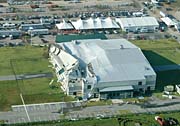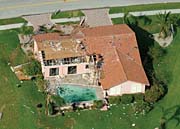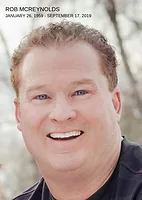A Summer to Remember: Charley, Frances, Ivan and Jeanne

"The industry is just slammed right now," says Steve Munnell, executive director of the Florida Roofing and Sheet Metal Contractors Association (FRSA). "We need about three to four weeks of sunshine and dry weather."
Gang of Four
The cruel irony of hurricanes is that they occur in the rainy season, where the humidity is thick and the damage enhanced. After Charley hit, the steady summer showers were further marred by Francis and Jeanne, who poured out their misery upon a weary populace. Damage is in the billions. Florida, which has a reputation for strong building codes and licensing, allows its licensed roofing contractors to move rather freely around the state, particularly in times of dire need.
Shortly after the first storm, Gov. Jeb Bush issued an executive order that allowed out-of-state contractors to replace or repair asphalt and wood shingles. Provisions like proof of workers' compensation and affidavits from their local jurisdiction would enable contractors 90 days to repair the storm damage. Munnell estimates that some 300,000 roofs in the state need repair but is not sure that many companies are meeting the standard.
"Finding a workers' comp policy is not going to be easy," says Munnell. "I would say at this point, not a whole lot [of temporary licenses] have been issued."
While FRSA offers its own self-insurance workers' comp coverage-among the oldest in the nation-the state has been battling high rates for years and availability is very limited for companies with no track record. Another option is working as a hired employee for a Florida firm. "Anybody can work as an employee," offers Munnell. "Of course, they don't really want to do that, for whatever reason."
FRSA did recently request that the governor allow Florida contractors to sub out work to out-of-state contractors that have been vetted. Florida had a tight labor market before this summer's nightmare, and the situation is getting more competitive. As in past storms, Munnell has heard plenty of stories about skilled roofers going to the highest bidder, driving up costs even more. He says that the material price increases announced in September are holding steady and a run of good weather in October should give the roofing industry some breathing space. Part of the battle will be convincing homeowners that getting back to normal will take awhile.
"Their roofs are dry, they just don't look good."

An Investment
Lee Crowther Sr., founder of Crowther Roofing & Sheet Metal of Florida in Fort Myers, was considering retiring this year. He started his company in 1974 and now has 400 employees and two satellite offices, along with a reputation for quality, safety and business acumen. Since Charley hit, he has been putting in 14-hour days, has purchased about $1 million in equipment and hired 100 new employees, including a crew from an associate in San Antonio."My resources are all used up," he says. "Our schedule says right now we need 250 people. And I know I won't get them."
Crowther is philosophical about hiring and training so many employees. Years of work lie ahead and the area is still booming with new construction. His experience tells him that the good ones will stay and natural attrition will take its toll. After all, he spent two years in the Miami area after Hurricane Andrew hit in 1992 and he knows the dynamics of post-storm economics: Desperate homeowners added to shortages in labor and materials mean another cycle of repairing the repair work. Once again, Crowther has seen some outrageous bids and is glad to focus strictly on commercial jobs. "Fortunately, we stay away from the residential market because I'd have a bunch of people mad at me."
He recently came back from West Palm Beach-which was affected twice this season-and has a crew there temporarily, but Crowther is too inundated locally to help any more. In fact, most Florida roofing contractors contacted by this reporter couldn't take the time to field a few questions. One in West Palm Beach had all calls forwarded to a single cell phone and was working in near Third World conditions.
Hurricanes impact a wide area and bring with them a demoralizing combination: massive damage that throws communities into the Stone Age. The normal pace of an on-demand society comes to a halt, while shocked residents and business owners use their wits to salvage what they can. For the first few weeks, construction is performed like triage: workers stabilize what they can until permanent repairs can be made.
Emergency Work
When Hurricane Charley passed over the Charlotte Regional Medical Center, the hospital lost 80 percent of its rooftop equipment and most of the existing BUR was torn off, exposing the concrete deck. The emergency room, intensive care unit and other critical areas were out of commission for a few days until Crowther could dry it in with a two-ply. Scott Ewing, job superintendent for Crowther, has been on site every day since the storm. He's pleased how well all the subcontractors are coordinating their efforts. "I've never been in a situation where everyone worked together so well," he says.That cooperation may stem from the shared trauma of all Floridians. Contractors are performing the "loaves and fishes" miracle with materials like plywood and felt so that there seems to be just enough to go around. M.J. Harris, the general contractor for the Medical Center job, had plywood on site as soon as the storm passed. Crowther has the latitude to pour new deck using its own equipment and is replacing undamaged sections of the roof since they're already set up. There was even a new industrial generator being installed amidst a buzz of activity.
On a sunny day in October, engineers, HVAC workers and roofers all worked around each other. This is the first weekend since Sept. 13 that the area hasn't been recovering from or bracing for a storm and the crews are making the most of it. Crowther has had to put some new construction and non-critical repairs on hold while it prioritizes work. Todd Adams, project manager, says that by the end of September, they had most of the salvageable roofs dry, a testament to the cooperation among trades. "The whole mind set seems to be different," he says. "Everyone's working towards the same goal. It's definitely different when you work in ground zero."
Even after buildings are rescued, there is still the long process of insurance claims. Many homeowners are finding that their policies don't cover the additional cost of bringing their old roofs up to code, which were updated statewide after Hurricane Andrew. Many business owners are wishing they had gotten business interruption coverage. Some truly unlucky business owners in Punta Gorda were punished for their speed when Jeanne flooded newly installed floors.
Crowther Roofing is humming along thanks to the careful preparation of Lee Sr. Before each storm, workers would see extra pallets of materials roll into the vast company compound. In addition to roll forming its own panels and pouring concrete decks, the company recently started doing its own trusses. Roof Check, a maintenance and simple repair program, had its 80 workers troubleshoot before the storms and were quickly back on the scene to make repairs afterward. The company's network of clients made communications easier, streamlined repairs and calmed nervous landlords. "We're still able to service our existing contracts," says Adams. "We're making progress. We're not deep sixing anybody."
When hospitals and schools need emergency repairs, most people are understanding. After all, 18 million people have gone through a season like this. Crowther has set up temporary offices on Fort Myers Beach, Sanibel Island and Port Charlotte, notifying whole blocks of customers as to when the company will be in their neighborhood. The company's sloped division-which mainly installs commercial tile-has seven crews making repairs, while trying to squeeze in shingle jobs on the weekend.
In many areas the devastation seemed random: a demolished home sits next to one with only a few shingles lost, roofing tiles stacked five high ride out the storm in Fort Myers while neighbors lost their carport. Other than the obvious impact of building codes, vegetation was a factor in minimizing some damage. Trees and bushes bore the brunt of the wind and protected many houses; even trees that fell over onto roofs did so gradually.
A category 4 hurricane has the potential to render most any roof into a missile and it is that completeness that still affects areas like Punta Gorda. Adams thinks it may be 10 to 15 years before his hometown fully recovers and the emotional toll will also linger. He has moved out of his house-heavily damaged during Charley-three times this year and like everyone else, is anxious to get back to some routine. For Adams, Charley is the last hurricane he'll ride out. "It's one of the most traumatic things I've been through," he sighs, trying to wipe the weariness from his face. "Everybody in Charlotte County is like that. Tired and worn out."
Looking for a reprint of this article?
From high-res PDFs to custom plaques, order your copy today!





